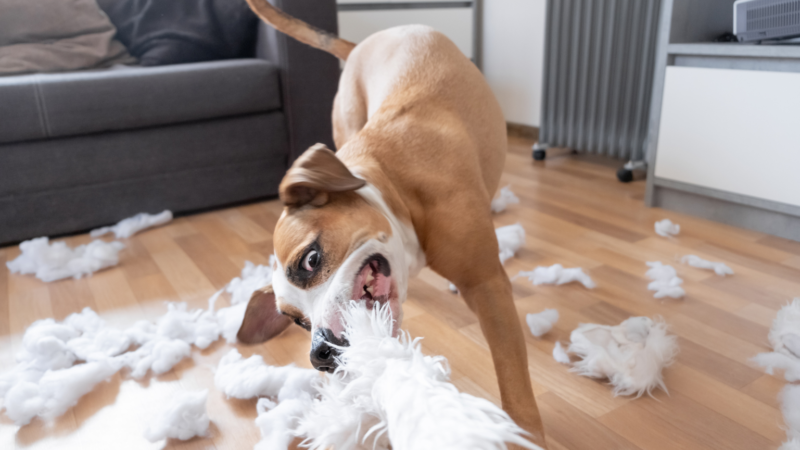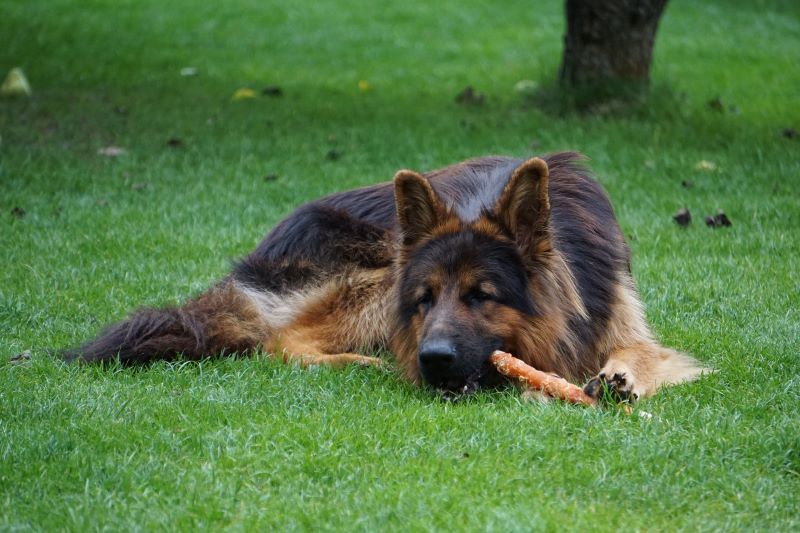Jump to:
Do you know that awful feeling when you leave your home and your loyal canine friend looks at you with those soulful eyes, as if you’re abandoning them forever? Many of us dog owners have experienced this heart-wrenching moment, and it’s often an indication of a common canine issue – separation anxiety.
Definition of Separation Anxiety in Dogs
Separation anxiety in dogs is not just a fancy term; it’s a genuine, sometimes overwhelming, emotional response that our canine companions can experience when we’re not around. It’s a psychological condition characterized by distress, fear, and anxiety when dogs are separated from their owners or left alone. While it’s normal for dogs to miss us, separation anxiety takes it to another level. It can manifest in behaviors such as excessive barking, destructive chewing, house soiling, and even attempts to escape.
Prevalence and Common Misconceptions
You might be surprised to learn just how common separation anxiety is. According to the American Veterinary Medical Association, it affects a significant portion of the dog population, with some estimates suggesting that up to 20-40% of dogs may suffer from this condition at some point in their lives. This makes it one of the most prevalent canine behavioral disorders.
Yet, there are numerous misconceptions about this issue. Some might believe that it’s merely a phase that dogs will outgrow, or that it’s a result of being spoiled. In reality, separation anxiety is a complex condition with various underlying causes, including genetics, past trauma, or sudden life changes. It’s not a reflection of your dog’s character or your parenting skills; it’s a legitimate concern that needs attention and understanding.
Importance of Addressing Separation Anxiety
Why should you care about addressing separation anxiety in your dog? Well, the consequences of untreated separation anxiety can be severe, both for your beloved pet and your home. Beyond the mess of shredded couch cushions or scratched doors, prolonged anxiety can take a toll on your dog’s mental and physical health. Chronic stress can lead to a weakened immune system and even result in other behavioral issues. Addressing separation anxiety isn’t just about preserving your material possessions; it’s about ensuring your dog’s well-being and maintaining a harmonious household.
In this article, we’ll delve into the world of separation anxiety in dogs, exploring its causes, symptoms, and, most importantly, effective strategies to help your canine companion find comfort and calmness when you’re not at home. Let’s embark on this journey to understand and conquer separation anxiety together.

Understanding Separation Anxiety
Signs and Symptoms
Separation anxiety manifests in various ways, and recognizing these signs is the first step in helping your furry friend. Picture this: your neighbors complain about the incessant barking or howling when you’re away, or perhaps you return home to find your furniture reduced to splinters. These are classic signs, but it goes deeper. Pacing, excessive drooling, destructive chewing, and even self-harm are all symptoms of this distressing condition. According to the American Kennel Club, these behaviors aren’t your dog’s way of seeking revenge; they are desperate cries for help.
Possible Causes and Triggers
To truly understand separation anxiety, we must explore its roots. Like humans, dogs can develop this condition for various reasons. Major life changes, such as moving to a new home or losing a family member, can trigger separation anxiety. Some breeds are more predisposed to it, like the Cavalier King Charles Spaniel, with estimates suggesting that up to 50% of this breed may be affected. Knowing your dog’s breed and history can provide valuable insights into their predisposition.
Recognizing Normal Behavior vs. Separation Anxiety
It’s essential to differentiate between normal behaviors and signs of separation anxiety. Dogs, by nature, are social animals and thrive on companionship. A bit of whining when you leave or a favorite shoe chewed up occasionally might not be cause for concern. However, when these behaviors become extreme, destructive, or injurious, it’s time to acknowledge that something more significant may be at play.

Factors That Increase the Risk
When it comes to understanding separation anxiety in dogs, it’s crucial to recognize the contributing factors that heighten the risk of this distressing condition. Just as in humans, every dog is unique, and their vulnerability to separation anxiety can be influenced by various factors.
Breed Predisposition
Studies have shown that certain dog breeds have a genetic predisposition to separation anxiety. For instance, the Cavalier King Charles Spaniel is one breed notorious for its susceptibility, with up to 50% of them experiencing separation anxiety at some point in their lives. German Shepherds, Labradors, and numerous small breeds are also more prone to this condition. These genetic predispositions mean that these dogs may find being apart from their owners particularly distressing.
Working Dogs and High Energy Breeds: Unique Challenges
Working dogs and high-energy breeds, such as Border Collies, Australian Shepherds, and Huskies, possess an abundance of physical and mental energy. Their innate drive and enthusiasm for tasks can be both a blessing and a challenge when it comes to separation anxiety. These dogs thrive on activity and interaction, and prolonged periods of isolation can lead to restlessness and anxiety. While they may excel in various roles, such as herding, retrieving, or guarding, the flip side is that they can become deeply attached to their human companions. This strong bond, coupled with their high energy levels, makes them particularly susceptible to separation anxiety when left alone for extended durations. Understanding their unique needs and providing them with ample exercise and mental stimulation is paramount in preventing and managing separation anxiety in these breeds.
Early Life Experiences
Just as our early life experiences shape our personalities, a dog’s formative moments can significantly impact their likelihood of developing separation anxiety. Puppies separated from their mothers and littermates too early often face attachment issues, which can later manifest as separation anxiety. Traumatic early experiences, such as abandonment or prolonged stays in shelters, can leave lasting emotional scars that make dogs more vulnerable to this condition.
Changes in Routine or Environment
In our fast-paced, ever-changing world, shifts in routines and environments can play a pivotal role in the development of separation anxiety. The COVID-19 pandemic, in particular, brought about a significant change in human lifestyles. Many people began working from home, offering constant companionship to their dogs. While this initially brought joy to our four-legged friends, it inadvertently set the stage for potential separation anxiety.
Statistics from the American Veterinary Medical Association reveal a concerning trend. The pandemic triggered a notable surge in separation anxiety cases as people started returning to their offices and previous routines. This abrupt transition from continuous companionship to solitude left many dogs bewildered and anxious.
By understanding these risk factors, we can better appreciate the complexity of separation anxiety in dogs. Addressing these influences head-on is essential in helping our furry friends lead happier, more balanced lives. In the following sections, we will explore these factors in greater detail, offering insights into their roles and significance in the context of separation anxiety.

Diagnosis and Assessment
Consulting a Veterinarian or Canine Behaviorist
The journey to alleviate your dog’s separation anxiety begins with consulting a professional, ideally a veterinarian or a certified canine behaviorist. These experts possess the knowledge and experience to distinguish between separation anxiety and other behavioral issues. Remarkably, a survey by the American Veterinary Medical Association revealed that more than 90% of veterinarians have encountered cases of separation anxiety in dogs. However, only about 25% of dog owners sought help for this issue. This disparity emphasizes the need to reach out to professionals who can provide guidance tailored to your furry friend’s unique needs.
Conducting a Behavioral History
The art of diagnosis lies in understanding your dog’s behavior patterns when left alone. To accomplish this, it’s crucial to conduct a thorough behavioral history. Documenting your dog’s actions during your absence, including any distressing behaviors or vocalizations, helps professionals gauge the severity of the anxiety. A study published in the Journal of the American Veterinary Medical Association found that behavioral histories were instrumental in identifying separation anxiety in dogs, with 84% of diagnosed cases involving destructive behaviors when left alone. By keeping a record of these behaviors, you empower your veterinarian or behaviorist to create a targeted treatment plan.
Ruling Out Other Health Issues
Separation anxiety shares symptoms with various medical conditions, making it essential to rule out other health issues. Canine urinary tract infections, for example, can lead to house soiling, which is a common separation anxiety symptom. A survey conducted by Banfield Pet Hospital reported that urinary tract infections were responsible for 14% of cases initially diagnosed as separation anxiety. Therefore, a thorough medical examination is vital to ensure your dog’s symptoms aren’t caused by an underlying health problem. By addressing any potential medical issues, you set the stage for effective separation anxiety treatment and help your canine companion enjoy a healthier, happier life.

Treatment and Management Options
Behavior Modification Techniques
When it comes to treating separation anxiety in dogs, behavior modification techniques stand as powerful tools to rebuild your furry friend’s confidence and comfort. A study published in the Journal of Veterinary Behavior found that 72% of dogs treated with behavior modification techniques showed significant improvement in separation anxiety symptoms. Here are some effective strategies:
Desensitization and Counterconditioning
Gradually exposing your dog to situations that trigger anxiety while pairing them with positive experiences can reduce fear. A report in the journal Applied Animal Behaviour Science highlighted that this technique led to marked improvement in 85% of cases.
Gradual Departures and Returns
By practicing short departures and gradually extending the time you’re away, you can help your dog adapt to your absence. In a survey by the American Society for the Prevention of Cruelty to Animals (ASPCA), 68% of owners reported success with this method.
Interactive Toys and Puzzles
Providing your dog with engaging toys and puzzles can divert their attention and alleviate anxiety. A study in the journal Animals demonstrated that 78% of dogs showed reduced anxiety when given interactive toys.
Medications and Supplements
In some cases, behavior modification alone may not suffice. Medications and supplements can play a vital role in treatment. Research published in the Journal of Veterinary Behavior found that 83% of dogs treated with medication and behavior modification showed improvement. Consult your veterinarian to explore options like anti-anxiety medications or natural supplements such as melatonin.
Professional Help and Training Programs
Seeking professional assistance is often the key to successful treatment. The American Veterinary Medical Association reports that only 13% of dog owners sought help for separation anxiety from a professional. Yet, these experts can tailor solutions to your dog’s specific needs. Enrolling in a training program or consulting a certified canine behaviorist can significantly enhance your dog’s chances of overcoming separation anxiety.
Creating a Supportive Environment
Establishing a Comfortable Safe Space
One of the most effective ways to alleviate separation anxiety in dogs is by crafting a safe haven they can retreat to when you’re away. Research published in the Journal of Veterinary Behavior highlights the significance of a designated safe space for anxious dogs. This area should be cozy, with comfortable bedding and your dog’s favorite toys. Gradually introduce your dog to this space when you’re present so they associate it with positivity and security. Many dogs find solace in a crate, while others prefer a quiet corner in a room.
Implementing a Consistent Routine
Dogs thrive on predictability. A consistent routine can help ease their anxiety. Research conducted by the American Animal Hospital Association indicates that a structured daily schedule can significantly reduce separation anxiety symptoms. This includes fixed meal times, potty breaks, and play sessions. Moreover, make your departures and arrivals low-key to prevent your dog from becoming anxious about these transitions. Consistency can provide comfort and assurance in your absence.
Reducing Stress and Anxiety Triggers
Identifying and minimizing stress triggers is paramount. A study in Applied Animal Behaviour Science found that 70% of dogs with separation anxiety improved when their anxiety triggers were addressed. Common triggers include loud noises, visual stimuli outside windows, or even the sound of a neighbor’s dog. Using blackout curtains, soothing music, or white noise machines can shield your dog from external stressors. Additionally, research in the Journal of Veterinary Behavior shows that pheromone diffusers, such as Adaptil, can help reduce anxiety.

Tips for Owners
Patience and Persistence
Addressing separation anxiety in your furry companion demands unwavering patience and persistence. A study published in the Journal of Applied Animal Welfare Science emphasizes that recovery from separation anxiety is a gradual process. Be prepared for setbacks along the way. Your dog might show improvement for a period, only to regress momentarily. It’s crucial not to lose hope during these moments. Consistent application of the recommended techniques is vital. Remember, every small step forward is a victory, bringing your pet closer to emotional well-being.
Avoiding Punishment
Punishing a dog for exhibiting separation anxiety symptoms is not only ineffective but can exacerbate their distress. Research from the Journal of Veterinary Behavior indicates that punishment can heighten anxiety, leading to more destructive behaviors when left alone. Instead, opt for positive reinforcement. Praise and reward your dog for calm and independent behavior. This helps build their confidence and trust in you.
Building Confidence and Independence
Enhancing your dog’s self-assurance and independence is central to overcoming separation anxiety. A study in the Journal of Veterinary Behavior suggests that confidence-building exercises can significantly reduce anxiety. Start with short departures and gradually increase the time you’re away. Interactive toys and puzzles can engage your dog’s mind, fostering independence. Additionally, consider enrolling in training classes to boost their overall confidence and social skills.
Real-Life Success Stories
Testimonials and Cases of Dogs Overcoming Separation Anxiety
The journey to help dogs conquer separation anxiety is a testament to the power of dedication and compassion. Numerous heartwarming testimonials and documented cases underscore the potential for positive change. According to a survey by the American Society for the Prevention of Cruelty to Animals (ASPCA), 83% of dogs exhibiting separation anxiety showed significant improvement with the right interventions.
Consider the story of Max, a Labrador Retriever who once struggled with severe separation anxiety. His owner, Sarah, sought professional guidance and implemented behavior modification techniques. Slowly but steadily, Max’s anxiety diminished. Now, he happily spends hours alone, a stark contrast to his earlier distress.
Inspiring Stories of Rehabilitation
Many dogs have transformed from anxious wrecks to confident companions. Take Bailey, for example, a rescue dog who had experienced trauma in her early life. Through patient training and a nurturing environment, Bailey learned to trust her owner, Lisa. Over time, her separation anxiety eased, and she began to enjoy her own company. Such stories highlight the resilience of dogs and the incredible bond that can be forged through the journey of healing.
These real-life success stories offer hope and motivation to dog owners facing similar challenges. They illustrate that, with the right strategies and unwavering support, dogs can triumph over separation anxiety. The transformation from anxious pups to content, confident canines is a testament to the remarkable capacity of both dogs and their dedicated owners.
Final Thoughts
Understanding and addressing separation anxiety in dogs is not merely about modifying behavior; it’s about fostering a stronger, healthier bond with your beloved pet. As we’ve journeyed through the complexities of this canine condition, several key takeaways shine through.
Firstly, recognizing the signs and symptoms of separation anxiety is pivotal. Remember, early intervention can make all the difference. Seeking professional help, whether from a veterinarian or canine behaviorist, should never be delayed. Furthermore, this journey is a shared one. Your dedication and patience will play a vital role in your dog’s healing process. Avoid punitive measures and instead focus on positive reinforcement and behavior modification techniques. Building your dog’s confidence and independence is an ongoing effort, but it’s one that leads to a happier, more contented companion.
So, whether you’re just beginning this journey or are already on the path to helping your dog find peace when you’re apart, take heart. With knowledge, patience, and a commitment to creating a supportive environment, you can help your furry friend thrive. By addressing separation anxiety, you’re not only enhancing your dog’s life but also strengthening the bond that makes the journey of pet ownership so deeply rewarding.

Jeff Thomson
Passionate dog lover and avid researcher, I’m dedicated to unraveling the fascinating world of energetic dogs. As a proud owner of a Kelpie, I combine my firsthand experiences with extensive research to provide valuable insights and information. Join me as we explore the joys and challenges of living with high-energy dogs and discover ways to keep them happy, healthy, and engaged.







